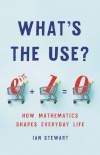- About MAA
- Membership
- MAA Publications
- Periodicals
- Blogs
- MAA Book Series
- MAA Press (an imprint of the AMS)
- MAA Notes
- MAA Reviews
- Mathematical Communication
- Information for Libraries
- Author Resources
- Advertise with MAA
- Meetings
- Competitions
- Programs
- Communities
- MAA Sections
- SIGMAA
- MAA Connect
- Students
- MAA Awards
- Awards Booklets
- Writing Awards
- Teaching Awards
- Service Awards
- Research Awards
- Lecture Awards
- Putnam Competition Individual and Team Winners
- D. E. Shaw Group AMC 8 Awards & Certificates
- Maryam Mirzakhani AMC 10 A Awards & Certificates
- Two Sigma AMC 10 B Awards & Certificates
- Jane Street AMC 12 A Awards & Certificates
- Akamai AMC 12 B Awards & Certificates
- High School Teachers
- News
You are here
What's the Use?

Publisher:
Basic Books
Publication Date:
2021
Number of Pages:
336
Format:
Hardcover
Price:
28.00
ISBN:
9781541699489
Category:
General
[Reviewed by , on ]
Fabio Mainardi
11/1/2021
“How mathematics shapes everyday life” is the subtitle of Ian Stewart’s latest book, connecting a variety of applications of mathematical theories to disparate fields such as politics, climate change or the car industry. However, what makes the book really interesting is the common underlying theme of the "unreasonable effectiveness" of mathematics, that is, the author selected examples of applications that “take good, usually new, mathematics and use it in an area that comes as a surprise, because that kind of mathematics wasn’t invented for that purpose at all” (p. 289).
For example, it is surprising that the Ising model, invented to describe the behavior of dipole moments in ferromagnetic materials, can also describe usefully the effects of climate change on the melting of sea ice.
Or that an abstract field such as algebraic topology is being increasingly applied to seek hidden patterns in numerical data. (This is now called topological data analysis and is being applied to genomics, viral evolution, and remote sensing).
It is not the author’s intention to contribute to the philosophical debate on why and how this unreasonable effectiveness happens. The book is really about popularizing a well-chosen collection of surprising applications.
All chapters can be read independently.
The content is perfectly accessible to an audience of non-mathematicians, each chapter introduces its topic (topology, complex numbers, number theory, etc) in a very simple language, starting from its historical development and the context of its original invention. References to recent research papers are given for the more mathematically educated readers who may want to better understand the novel and unreasonable applications of the theory.
Most of these applications I was already aware of, but some were a pleasant discovery: for example the applications of space-filling curves to high-performance data mining. (Hilbert curves are now implemented in the R package Bioconductor.) So I believe that this book can also make interesting reading for professional mathematicians, while still being a book that you can offer to a non-mathematician, but curious-minded friend.
The style is clear and very enjoyable, as customary with Ian Stewart’s books.
Fabio Mainardi (fabio.mainardi@rd.nestle.com) works as senior data scientist at Nestlé Research, Lausanne. After a PhD in number theory, he has been working as applied mathematician in R&D divisions of different companies. His mathematical interests include statistical models, probability, discrete mathematics and optimization theory.
See the publisher's website.
- Log in to post comments




